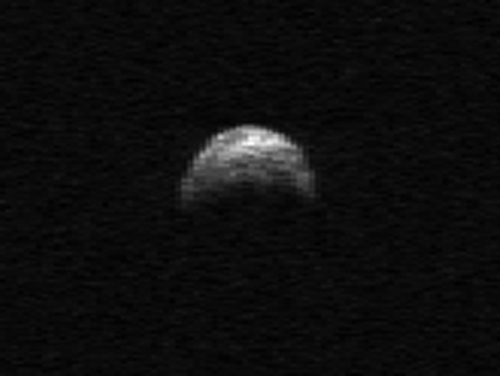A massive asteroid will make a rare fly-by Tuesday, and although it poses no danger of crashing to Earth, US scientists said this week they are eager for a closer look.

"This is not a potentially hazardous asteroid, just a good opportunity to study one," said National Science Foundation astronomer Thomas Statler.
The circular asteroid, named 2005 YU55, is about 1,300 feet (400 meters) wide and will come closer than the Moon, zipping by at a distance of 202,000 miles (325,000 kilometers), the US space agency said.
The time of the nearest flyby is expected to be at 2328 GMT (6:28 Eastern time in the US).
The encounter will be the closest by an asteroid of that size in more than 30 years, and a similar event will not happen again until 2028.
However, those who want to see will need a telescope.
The asteroid is "going to be pretty faint when it flies by," said Scott Fisher, program director of the National Science Foundation's Division of Astronomical Sciences.
"It will not be visible to the naked eye. You will need a telescope that has a mirror at least six inches in size to see it. To make it even more difficult to observe, it will be moving very quickly across the sky as it passes."
Several radar telescopes are set up in North America to catch glimpses of the space rock, Fisher added.
"The best time (and place) to observe it would be in the early evening on November 8th from the east coast of the US."
Astronomers who have studied the object, part of the C-class of asteroids, say it is very dark, like the color of charcoal, and quite porous.
It was first discovered in 2005 by Robert McMillan of the Spacewatch Project, a solar-system-scanning group of scientists near Tucson, Arizona.
While 2005 YU55 will stay a safe distance away, it is part of a crew of
1,262 big asteroids circling the Sun and measuring more than 500 feet (150 meters) across that NASA classifies as "potentially hazardous."
"We want to study these asteroids so if one does look like it may hit us someday, we'll know what to do about it," Statler said.
The asteroid's closest pass is set to take place in 2094, at a distance of 167,000 miles (269,000 kilometers), according to forecasts.
"The observations will give us a piece of the puzzle, one we don't get many chances to see," said Don Yeomans of NASA's Jet Propulsion Laboratory.
"At one time, we thought these were the asteroids that delivered carbon and other elements to the early Earth, so they are pretty important."
NASA said the last time a space rock this big approached Earth was in 1976, "although astronomers did not know about the fly-by at the time." (AFP)
<한글 기사>
항공모함만한 소행성 내일 근접..핵폭탄 5백기급
항공모함 크기의 소행성이 오는 8일 달보다 더 가까운 거리까지 지구에 근접한다고 미국 워싱턴포스트(WP)가 3일 보도했다.
미 항공우주국(NASA)은 '2005 YU55'(이하 YU55)로 알려진 이 소행성이 8일 지구 에서 32만km가량 떨어진 지점을 통과한다고 밝혔다. 이는 달의 공전궤도 안쪽으로, 달과 지구 사이 평균거리는 약 38만4천400km다.
NASA는 이 소행성이 시속 4만8천km의 속도로 지구를 향해 돌진하고 있지만 충돌 위험은 없다고 설명했다.
그러나 퍼듀대의 제이 멜로쉬 교수는 YU55 크기의 소행성이 지구와 충돌하면 핵 폭탄 500개가 폭발하는 것과 똑같은 효과가 발생, 규모 7.0의 지진과 21m 높이의 쓰 나미를 몰고 올 것으로 예측했다.
YU55 수준의 대형 소행성이 지구에 근접하는 것은 지난 1976년 이후 처음 있는 일이다.
게다가 YU55는 탄소를 많이 포함한 'C형' 소행성이기 때문에 태양계와 생명의 기원을 연구하는 많은 과학자들의 관심이 증폭되고 있다.
태양계가 형성될 당시 최초 물질이 어땠는가를 보여주는 대표적 소행성이 바로 C형이다.
또 YU55와 비슷한 종류의 소행성은 '탄소질 콘드라이트'라고 부르는데, 이는 아 미노산 등 생명체를 구성하는 물질을 다수 함유한다.
NASA 지구접근물체 프로그램의 돈 요만스 연구원은 "초기 지구에 충돌한 탄소질 콘드라이트는 탄소를 기반으로 한 물질과 물을 남겨줘 생명체가 탄생할 수 있었을 것"이라고 말했다.
1980년대 단 하나의 망원경으로 소행성 관측을 시작한 NASA는 현재 연간 500만 달러(약 56억원)의 예산으로 소행성 추적 프로그램을 진행하고 있다.
NASA는 충돌 시 큰 피해가 예상되는 지름 1km 이상의 '플래닛 킬러' 소행성을 9 0% 이상 추적했으며, 이들이 앞으로 지구와 충돌할 가능성은 없다고 진단했다.




![[KH Explains] No more 'Michael' at Kakao Games](http://res.heraldm.com/phpwas/restmb_idxmake.php?idx=644&simg=/content/image/2024/04/28/20240428050183_0.jpg&u=20240428180321)





![[Grace Kao] Hybe vs. Ador: Inspiration, imitation and plagiarism](http://res.heraldm.com/phpwas/restmb_idxmake.php?idx=644&simg=/content/image/2024/04/28/20240428050220_0.jpg&u=)







